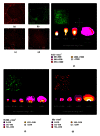Early neural cell death is an extensive, dynamic process in the embryonic chick and mouse retina
- PMID: 23710143
- PMCID: PMC3654239
- DOI: 10.1155/2013/627240
Early neural cell death is an extensive, dynamic process in the embryonic chick and mouse retina
Abstract
Orchestrated proliferation, differentiation, and cell death contribute to the generation of the complex cytoarchitecture of the central nervous system, including that of the neuroretina. However, few studies have comprehensively compared the spatiotemporal patterns of these 3 processes, or their relative magnitudes. We performed a parallel study in embryonic chick and mouse retinas, focusing on the period during which the first neurons, the retinal ganglion cells (RGCs), are generated. The combination of in vivo BrdU incorporation, immunolabeling of retinal whole mounts for BrdU and for the neuronal markers Islet1/2 and β III-tubulin, and TUNEL allowed for precise cell scoring and determination the spatiotemporal patterns of cell proliferation, differentiation, and death. As predicted, proliferation preceded differentiation. Cell death and differentiation overlapped to a considerable extent, although the magnitude of cell death exceeded that of neuronal differentiation. Precise quantification of the population of recently born RGCs, identified by BrdU and β III-tubulin double labeling, combined with cell death inhibition using a pan-caspase inhibitor, revealed that apoptosis decreased this population by half shortly after birth. Taken together, our findings provide important insight into the relevance of cell death in neurogenesis.
Figures




References
-
- Hamburger V, Levi-Montalcini R. Proliferation, differentiation and degeneration in the spinal ganglia. The Journal of experimental zoology. 1949;111(3):457–501. - PubMed
-
- de la Rosa EJ, de Pablo F. Cell death in early neural development: beyond the neurotrophic theory. Trends in Neurosciences. 2000;23(10):454–458. - PubMed
-
- Yeo W, Gautier J. Early neural cell death: dying to become neurons. Developmental Biology. 2004;274(2):233–244. - PubMed
-
- Buss RR, Sun W, Oppenheim RW. Adaptive roles of programmed cell death during nervous system development. Annual Review of Neuroscience. 2006;29:1–35. - PubMed
Publication types
MeSH terms
LinkOut - more resources
Full Text Sources
Other Literature Sources
Research Materials

